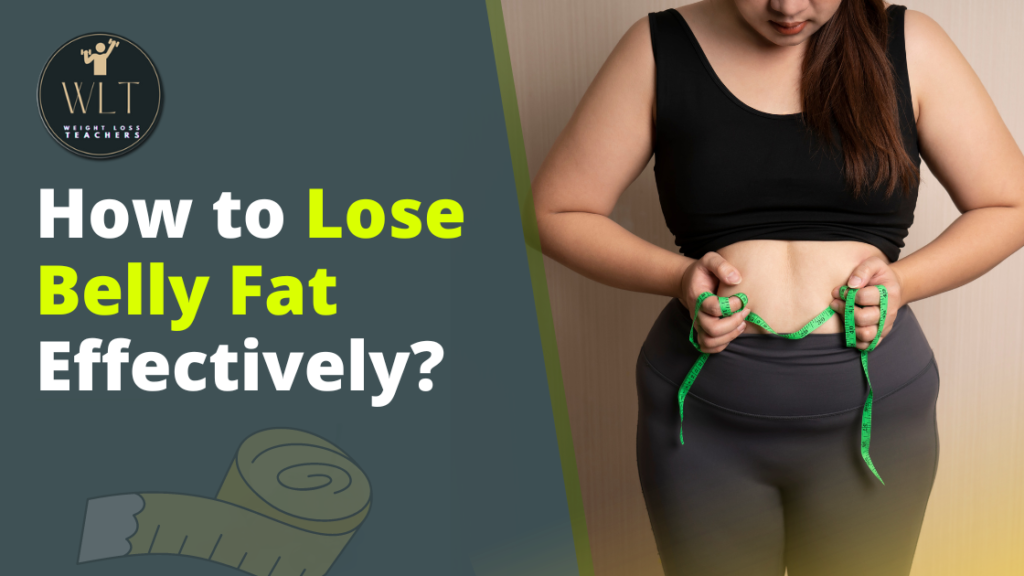
How to Lose Belly Fat Effectively?

Are you seeking answers to “How do I lose belly fat?” You’ve just arrived at the right place. Losing belly fat can be a stressful and difficult task, but it is doable with the appropriate tactics and mindset.
Table of Contents
Introduction
Belly fat, also known as visceral fat, is fat collected around your organs and has been linked to a variety of health issues, including diabetes, heart disease, and stroke. In this detailed article, we will look at effective techniques to decrease belly fat and improve your overall health, giving you the information and skills you need to reach your weight loss objectives. Read further to gain vital insights on how to lose belly fat.
How to Lose Belly Fat
Find the right answers to your questions like “How do I lose belly fat?” and “What is the best way to lose belly fat?” here.
Consume a Well-Balanced Diet
A healthy diet is essential for decreasing abdominal fat. You must establish a calorie deficit by burning more calories than you ingest to lose weight. It is crucial to realize, however, that not all calories are created equal. As one of the best ways to lose belly fat, a nutrient-dense diet will not only help you lose weight but will also supply important elements for general wellness.
It is critical to incorporate lean protein sources into your meals if you want to lose weight. Protein promotes feelings of fullness and contentment, which can lead to a reduction in overall calorie intake. Lean protein sources include chicken, turkey, fish, eggs, tofu, and lentils. They provide important amino acids for muscle repair and growth, which might enhance your metabolism and help you lose weight.
Whole grains are another key part of a healthy diet. They are high in fiber, which assists digestion, induces satiety, and aids in blood sugar regulation. Whole grains that can be incorporated into your meals include brown rice, quinoa, oats, and whole-wheat bread.

Fruits and vegetables are high in important vitamins, minerals, and fiber while being low in calories. They provide a variety of nutrients while adding bulk to your meals, allowing you to feel full on fewer calories. Berries, apples, oranges, spinach, kale, and broccoli are all nutrient-dense foods that you can incorporate into your daily diet.
It is critical to include healthy fats in your diet for satiety and overall health. Avocados, nuts, seeds, olive oil, and fatty fish such as salmon are high in monounsaturated and polyunsaturated fats, which have been linked to a variety of health advantages. These fats enhance feelings of fullness and can aid in the reduction of cravings for harmful meals.
It is also critical to avoid processed and high-calorie foods, which can lead to weight gain and raise the risk of health problems. Fast food, sugary drinks, and baked goods are frequently heavy in unhealthy fats, added sugars, and refined carbohydrates, which can lead to weight gain and the accumulation of belly fat.
You can efficiently lose belly fat by eating a balanced diet that contains lean protein, whole grains, fruits, vegetables, and healthy fats while avoiding processed and high-calorie items.

Consume Fiber-Rich Foods
Including fiber-rich foods in your diet can help you lose belly fat. High-fiber foods not only keep you satiated for longer, but they also aid with weight loss and digestion.
Fiber adds heft to your meals, which might help you lose weight by increasing fullness. It also slows digestion and nutritional absorption, avoiding blood sugar surges and aiding in appetite regulation.
Whole grains, fruits, vegetables, legumes, and nuts are all good sources of nutritional fiber. Brown rice, quinoa, oats, berries, apples, oranges, spinach, kale, lentils, and almonds should all be included in your meals and snacks.
You can achieve weight loss goals, enhance digestive health, and potentially reduce belly fat by eating fiber-rich foods in your diet.

Practice Intermittent Fasting
Intermittent fasting is a nutritional practice in which fasting and eating periods alternate. It has grown in popularity because of its ability to aid in weight loss, reduce abdominal fat, and improve metabolic health.
There are other methods of intermittent fasting, but the two most frequent are the 16/8 approach and the 5:2 method. The 16/8 approach requires you to fast for 16 hours and limit your eating window to 8 hours per day. During the fast, you only drink calorie-free drinks such as water, unsweetened tea, or coffee. The 5:2 technique involves eating regularly five days a week and limiting calorie consumption to 500–600 calories on two non-consecutive days.
Intermittent fasting can aid in weight loss by lowering overall calorie intake and encouraging fat burning. Furthermore, it may improve insulin sensitivity and hormone balance, which can help with belly fat reduction.
It is crucial to note, however, that intermittent fasting may not be ideal for everyone. Before beginning any fasting regimen, listen to your body and speak with a healthcare practitioner, especially if you have underlying health concerns or are taking medication.

Stick to a Low-Calorie Diet
Exercise Portion Control
While eating a well-balanced diet is vital, so is practicing portion control. When consumed in excess, even nutritious meals can lead to weight gain.
You may control portion sizes by doing the following:
- Use smaller plates and bowls to give the appearance of a fuller plate.
- Follow the recommended serving sizes and, if necessary, measure or weigh your food.
- Avoid eating directly from the packaging because it can lead to mindless overeating. Instead, spoon a suitable serving size onto a plate or bowl.
- Be aware of your body’s hunger and fullness cues. Eat slowly and pay attention to your body’s cues to identify when you’re full.
- By exercising portion management, you can sustain a calorie deficit and aid in the reduction of belly fat.

Practice the Best Exercises Daily
Regular exercise, in addition to a healthy diet, is a significant aspect of decreasing belly fat. Determine the best exercise to lose belly fat according to your capabilities and incorporate it into your daily routine. Exercise not only burns calories, but it also helps develop muscle, which can boost your metabolism and help you lose weight.
Aim for 150 minutes per week of moderate-intensity activity, such as brisk walking, cycling, swimming, or dancing. These activities raise your heart rate and aid in the burning of calories. Cardiovascular workouts are good for fat loss in general, including belly fat.

Do Cardiovascular Workouts
Including cardiovascular workouts in your fitness program, in addition to the best exercises to lose belly fat, will help you burn calories, lose belly fat, and improve your overall health. Cardiovascular activities raise your heart rate and metabolism, resulting in enhanced calorie burn.
Activities like brisk walking, jogging, cycling, swimming, dancing, or using cardio devices like the treadmill or elliptical trainer are some of the popular exercises to lose belly fat. Aim for at least 150 minutes of moderate-intensity cardio every week, or 75 minutes of vigorous-intensity cardio if you can.
Varying your cardio workouts while doing the best exercise to lose belly fat regularly can help you avoid boredom and stay motivated. Consider attempting new activities or enrolling in group programs to spice up your routine and make it more pleasurable.

Practice Core Exercises to Lose Belly Fat
While aerobic activity is crucial for general weight loss, adding strength and core exercises to your regimen can help strengthen your muscles, improve your posture, and tone your abdominal muscles.
Weightlifting, resistance band workouts, or bodyweight activities like push-ups, squats, and lunges are some of the exercises to lose belly fat that can help enhance muscle mass and metabolism. When you gain muscle, your body becomes more efficient at burning calories, even when you are at rest.
Using exercises like planks, crunches, Russian twists, and similar exercises to lose belly fat and target your core muscles will help tone and strengthen your abdominal muscles, giving you a tighter and more defined abdomen.
Including strength training and the best exercises to lose belly fat in your fitness routine, in addition to aerobic activities, will help you lose belly fat and achieve a toned and sculpted appearance.
You may increase calorie burn, build lean muscle mass, and ultimately reduce belly fat by combining regular cardiovascular exercise with strength training.

Maintain Consistency and Have Patience
It takes time, persistence, and patience to lose belly fat and achieve weight loss goals, even if you adopt the best way to lose belly fat. It’s critical to remember that long-term weight loss is a process, not an overnight transformation.
Avoid fast-fix diets or excessive tactics that promise immediate results. These methods are frequently unsustainable and might be harmful to your general health.
Instead, concentrate on establishing long-term lifestyle changes that you can stick to. Adopt a good and balanced diet, engage in regular physical activity, reduce stress, prioritize sleep, and remain hydrated.
Keep track of your progress and celebrate tiny triumphs along the way. Remember that losing weight is about more than just the numbers on the scale; it is also about improving your total health and well-being.
Don’t be discouraged if you face setbacks or difficulties. Learn from their mistakes, rethink your strategy if required, and keep moving forward. Seek advice and encouragement from friends, family, and professionals who can help you along the way.

Reduce Your Stress
Stress can have a substantial impact on weight growth and the formation of abdominal fat. When you are stressed, your body produces cortisol, a stress hormone that increases fat storage, especially in the abdomen.
Stress reduction is beneficial to general health and can aid in the reduction of abdominal fat. There are various excellent stress management and relaxation practices that you can implement into your everyday routine.
Deep breathing exercises can aid in the activation of the body’s relaxation response and the reduction of stress. Taking slow, deep breaths and focusing on your breathing will help you relax your mind and body. Incorporate deep breathing exercises into your daily routine, such as sitting quietly for a few minutes in the morning or evening to breathe deeply.
Meditation and yoga have been proven to alleviate stress and increase relaxation. Regular participation in these activities can help to relax the mind, promote mental well-being, and lower cortisol levels. You may incorporate these practices into your routine by enrolling in a local yoga class or using guided meditation apps or videos.
Hobbies and activities that you enjoy might also help you manage stress. Find hobbies that make you happy and make time for them regularly. Painting, gardening, playing a musical instrument, or reading are all examples of activities that might distract your mind from pressure and encourage relaxation.
Spending time with friends, family, and pets can also help reduce stress. Social support and genuine connections can aid in stress reduction and overall well-being. Make time for social activities and prioritize relationships with family and friends.
Another helpful stress-management method is mindfulness practice. Paying attention to the current moment without judgment is what mindfulness entails. It can be done during everyday tasks such as eating, walking, or even dishwashing. You can minimize stress and increase your general well-being by being totally present in the moment and focusing on your senses.
You can reduce cortisol production, stress levels, and potentially belly fat buildup by implementing stress management practices into your everyday routine.
Get Enough Sleep
Sleep is frequently disregarded, although it is essential for weight loss and overall wellness. Sleep deprivation can interfere with your metabolism, increase your appetite, and make you seek high-calorie foods, making even the best way to lose belly fat futile.
To help with weight loss, aim for 7-9 hours of quality sleep per night. By going to bed and waking up at the same time every day, you can help regulate your body’s internal clock and improve your sleep quality.
It is also critical to create a sleep-friendly environment. Ascertain that your bedroom is dark, quiet, and at a suitable temperature. Avoid using electronic gadgets before going to bed since the blue light they create can disrupt your sleep. Instead, prepare your body for sleep by engaging in soothing activities such as reading a book, taking a warm bath, or practicing relaxation techniques.
You can assist your weight loss objectives and lower the risk of weight gain and belly fat accumulation by prioritizing sleep and maintaining appropriate rest.
Note: There might be affiliate links mentioned here. We may receive a commission if you purchase a product through an affiliate link. There is no additional charge for you. Please do your own research before making any online purchases.
Consume Plenty of Water
Drinking adequate water is not only important for overall health, but it can also help with weight loss and belly fat reduction. Water keeps you hydrated, aids digestion, and might suppress your appetite.
Aim for at least 8 glasses of water per day, or more if you exercise or live in a hot climate. Drinking water before meals might help you feel fuller, which can lead to a lower calorie intake. Staying hydrated can also help raise your metabolism, helping your body burn calories more efficiently.

It is critical for weight loss to replace sugary drinks like soda and juice with water. These beverages are frequently heavy in calories and added sugars, which can lead to weight gain and the production of belly fat. Choose water as your primary beverage, and if desired, flavor it with pieces of fruit or herbs.
You may help your weight reduction journey and minimize belly fat by remaining hydrated and emphasizing water as your beverage of choice.

Stay Away from Alcohol
Alcohol use has been linked to weight gain and the buildup of belly fat. Alcoholic beverages are heavy in calories and can cause metabolic disruption, resulting in increased fat storage, particularly in the abdomen area. Even the best way to lose belly fat will not be effective with uncontrolled alcohol consumption.
If you choose to consume alcohol, it is critical that you do so in moderation. Limit your alcohol consumption and choose lower-calorie options like wine or light beer. Consider the calories you take in from alcohol and how they may affect your weight-loss efforts.

How to Lose Belly Fat with Other Methods
Aside from the lifestyle adjustments described above, there are a number of non-surgical procedures that can help with fat and weight loss. When performed under the supervision of a healthcare expert, these approaches are often safe and effective. Here are a few popular non-surgical options:
- Cool Sculpting: Also known as cryolipolysis, CoolSculpting is a non-invasive fat reduction process that uses controlled chilling to freeze and destroy stubborn fat cells. It is frequently used to target specific areas like the abdomen, thighs, and love handles. The body naturally eliminates the frozen fat cells over time, resulting in a more contoured appearance.
- Laser lipolysis: Laser lipolysis, also known as laser-assisted liposuction, is a minimally invasive surgery that liquefies and removes fat cells using laser radiation. It can be used on a variety of body parts and is especially useful for targeting small, localized fat deposits. Additionally, the technique encourages collagen formation, resulting in tighter, firmer skin.
- Radiofrequency treatments: Radiofrequency energy is used to heat the skin’s deeper layers, encouraging collagen formation and tightening loose skin. Cellulite and sagging skin in places such as the abdomen, thighs, and arms can be improved with these therapies.
- Ultrasound therapy: Ultrasound therapy uses high-intensity focused ultrasound (HIFU) energy to target and kill fat cells while leaving surrounding tissues unharmed. This non-invasive method can be used to eliminate fat from the abdomen, flanks, and thighs. It also stimulates collagen formation, which results in skin tightening.
- Injection-based treatments: Injection-based treatments, such as lipotropic injections or mesotherapy, involve the injection of specific chemicals into specific parts of the body to aid in fat breakdown and metabolism. These injections frequently include a combination of vitamins, amino acids, and enzymes that aid in fat burning and weight loss.
- Non-surgical gastric balloons: Non-surgical gastric balloons are temporary devices inserted in the stomach to promote portion control and induce a feeling of fullness. They are placed via endoscopic surgery and can stay in the stomach for months. The appearance of the balloon encourages people to eat smaller meals and consume fewer calories, resulting in weight loss.
Non-surgical body contouring treatments, such as high-intensity focused electromagnetic (HIFEM) technology or radiofrequency devices, can help tone and sculpt the body by activating muscle contractions and increasing muscle definition.
These treatments are especially effective for people who want to improve muscle tone and lose stubborn fat in places like the belly and buttocks.
It should be noted that these non-surgical treatments are not intended to substitute for a healthy diet and exercise. They are typically targeted at people who have already made lifestyle adjustments but are still suffering from stubborn fat deposits or who require further assistance to attain their goals. It is critical to consult with a skilled healthcare practitioner to evaluate if these therapies are appropriate for your unique needs and to ensure their safe and effective implementation.
Remember that long-term weight loss and fat reduction necessitate a multifaceted approach that includes a well-balanced diet, frequent exercise, and good lifestyle behaviors. Non-surgical approaches can supplement these efforts, but they should be viewed as supplements rather than stand-alone remedies.
As a result, non-surgical procedures, including CoolSculpting, laser lipolysis, radiofrequency treatments, ultrasound therapy, injection-based treatments, non-surgical gastric balloons, and non-surgical body sculpting treatments, can help with fat and weight loss. However, in order to achieve long-term outcomes, it is critical to consult with healthcare professionals and maintain a healthy lifestyle.
FAQs
What exactly is belly fat, and why is it a health issue?
Belly fat, also known as visceral fat, is fat that accumulates around organs and is associated with health problems such as diabetes and heart disease.
How can I efficiently lose abdominal fat?
Focus on a balanced diet, fiber-rich foods, intermittent fasting, regular exercise, stress management, sleep prioritization, and staying hydrated to decrease abdominal fat.
What foods should I eat as part of a balanced diet to lose abdominal fat?
Consume lean proteins, whole grains, fruits and vegetables, and healthy fats such as avocado and nuts.
Are there exercises that specifically target abdominal fat?
While overall activity is important, integrating core movements such as planks and crunches can assist develop and tone the abdominal muscles.
Can intermittent fasting aid in the reduction of abdominal fat?
By lowering overall calorie intake and boosting insulin sensitivity, intermittent fasting can help with weight loss, particularly belly fat reduction.
What role does portion control have in decreasing abdominal fat?
Portion control aids in the maintenance of a calorie deficit, which aids in the decrease of belly fat.
Is it possible to lose abdominal fat by following a low-calorie diet?
When followed under supervision, a low-calorie diet can help establish a calorie deficit and encourage weight loss, including a reduction in belly fat.
What effect does stress have on abdominal fat?
Stress causes the body to produce cortisol, a hormone linked to fat storage, especially belly fat. It is beneficial to reduce stress through several practices.
Can getting adequate sleep aid in the loss of abdominal fat?
Adequate sleep influences metabolism and appetite, lowering the risk of weight gain and formation of belly fat.
Does drinking water aid in the loss of abdominal fat?
Water promotes digestion, lowers hunger, and boosts metabolism, all of which contribute to weight loss, including belly fat reduction.
Conclusion
Finally, decreasing belly fat necessitates a diverse approach that includes a well-balanced diet, frequent exercise, stress management, proper sleep, hydration, and possibly intermittent fasting. It’s vital to remember that losing weight and getting rid of abdominal fat take time and may not happen overnight. Set attainable goals, maintain consistency, and be patient with your development.
It’s also critical to pay attention to your body and make any necessary modifications. Every person is unique, and what works for one person may not work for another. Focus on identifying the tactics and lifestyle adjustments that work best for you and making long-term improvements that you can stick with.
Remember that seeking help from a healthcare expert or a qualified dietitian who can provide individualized direction and support during your weight loss journey is always advantageous. You may successfully decrease belly fat, improve your health, and improve your general well-being with determination, perseverance, and the appropriate tactics.
Disclaimer: The information provided in this article is for educational purposes only and should not be considered as a substitute for medical advice. Consult a healthcare professional before implementing any home remedies or making significant changes to your lifestyle.






